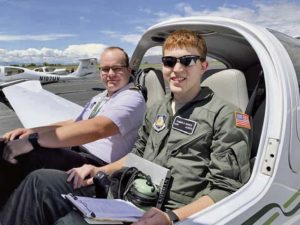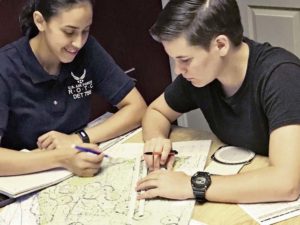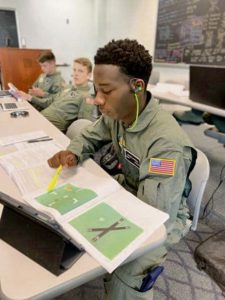by Air Force Junior Reserve Officer Training Corps Flight Academy

MAXWELL AIR FORCE BASE, Ala. — In 2018, almost half of all newly licensed female pilots between the ages of 17 and 19 were graduates of the Air Force Junior Reserve Officer Training Corps Flight Academy.
This year, 150 cadets each received a scholarship from the Chief of Staff of the Air Force Scholarship Program to attend one of 11 universities across the country for an intensive eight-week program, and 45 percent of the class was female or minority.
In the end, 122 Air Force Junior ROTC high school students walked away with a positive university experience, college credit and their private pilot certification.
Could the Flight Academy change the face of aviation in the U.S.?
“There are a lot of great aviation programs around doing good work, but the numbers and pilot diversity have not changed,” said Gary Morrison, Aviation Accreditation Board International chairperson. “That is not the case with Air Force Junior ROTC. The program provides quantifiable measurements of success and access to the single largest group of competitive and diverse students. AABI is excited to be an integral part in this very innovative program to reach students who might not otherwise be able to fulfill their dreams in aviation.”
The Air Force Junior ROTC Flight Academy’s mission is twofold: increasing the luster of aviation by getting teenagers excited about aviation and increasing diversity in the aviation community.
“I hope the Air Force continues to recognize the untapped potential of this program,” Morrison said. “The pilot shortage is a national problem and the Air Force has stepped out front to create opportunities for students with no military requirement. The aerospace industry, as well as education, foundational investors, regulators and workforce development teams need to be a part of this effort.”

Only in its second year as an Air Force program, the Flight Academy has blown away the national averages in diversity, with the largest increase in the amount of female participation. This year, the Flight Academy boasted 28 percent female representation, a 50 percent increase over last year’s program, and minority representation increased by 26 percent.
These numbers stand out when considering that females only make up 5 to 7 percent of all pilots in industry or military and only 10 to 11 percent are minorities, according to the Air Force Air Crew Crisis Task Force.
Air Force Junior ROTC is one of the most diverse education programs in the Air Force, with 125,000 cadets worldwide at almost 880 locations.
“We were so impressed with the diversity of the students. We saw not only diversity in terms of women and minorities, but also in terms of socio-economic strata, parents’ educational backgrounds and hometown locations,” said Dr. Manoj Patankar, head of Aviation and Transportation Technology, Purdue University, Indiana. “These cadets came to Purdue University with unique backgrounds and diverse world views. In the end, they emerged not only as fully qualified pilots, but also as well-rounded individuals, ready to be better global citizens.”
Earning their private pilot certification was not easy, especially in such a short amount of time.
“These Air Force Junior ROTC cadets accomplished in eight weeks what usually can take our regular university students 22 to 28 weeks during a normal academic year,” said Michael Hales, Delaware State University director of Aviation Programs. “I wish we had an entire aviation program full of students with the drive and focus that our cadets had.”
The cadets came together from all over the world and quickly formed friendships. At times they were working up to six days a week and into the late evening to meet the program requirements.

“I admit, I was a skeptic at first,” said Dr. Elizabeth Bjerke, University of North Dakota John D. Odegard School of Aerospace Sciences associate dean. “Obtaining a private pilot certificate in just two months is a very big challenge for anyone.…I feared low completions. I am very happy to admit that I was wrong. Through the effective selection process put into place by Air Force Junior ROTC, we had great success in our program.”
The Air Force Junior ROTC Flight Academy is intended to expose high school students to the benefits of a career in aviation. The scholarship covers transportation, room and board, academics and flight hours required to potentially earn a private pilot certification. More than 1,560 cadets applied for one of the 150 scholarships valued at approximately 20,000 dollars each. The cadets were competitively boarded to ensure only the most qualified cadets were sent to the partner universities.
In two years, the Flight Academy has produced 217 new pilots. This year, 117 Flight Academy cadets graduated from high school. Although there are no military requirements for the scholarship, 51 cadets were offered Air Force ROTC scholarships and 16 cadets were offered Air Force Academy appointments.
“Students may choose a career in commercial or military aviation, and we hope they do,” said Todd Taylor, Air Force Junior ROTC Program Development chief. “However, they have taken the first step to becoming tomorrow’s aviation leaders.”
“I can confidently say that these students performed as good as or better than our residential degree-seeking students,” Patankar said. “We would be glad to admit all of them. As some of the flight instructors observed, these students faced challenges and setbacks, but they persevered, and they kept each other motivated.”


